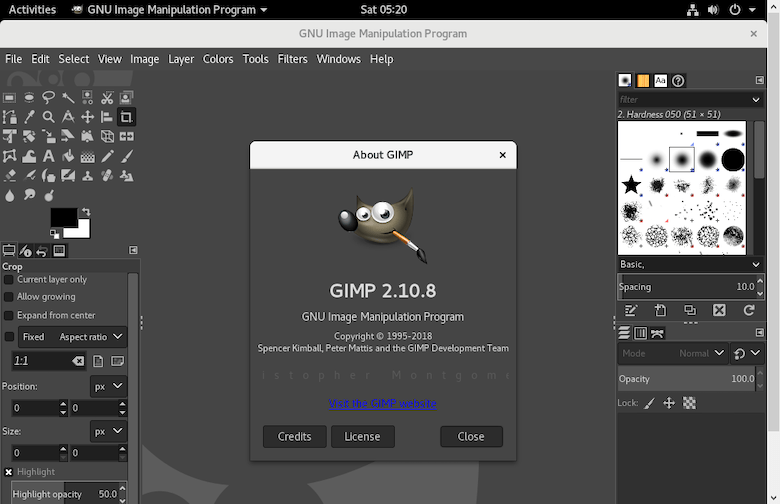How To Install GIMP on Fedora 41

GIMP has long been a staple in the Linux community, offering a robust set of tools for graphic designers, photographers, and hobbyists alike. The latest version, GIMP 3.0, brings significant improvements and new features that make it an even more compelling choice for Fedora 41 users.
Fedora 41, known for its cutting-edge software and commitment to free and open-source principles, provides an ideal platform for GIMP 3.0. The integration of this powerful image editor into Fedora’s ecosystem offers users a seamless experience, combining the stability of Fedora with the versatility of GIMP.
Whether you’re a seasoned graphic designer or a curious newcomer to image editing, installing GIMP on Fedora 41 opens up a world of creative possibilities. From basic photo retouching to complex digital art creation, GIMP provides the tools you need to bring your visual ideas to life.
Prerequisites
Before diving into the installation process, it’s crucial to ensure your system meets the necessary requirements. This will help avoid potential issues and ensure a smooth installation experience.
System Requirements
- Processor: Any modern x86-64 processor (Intel or AMD)
- RAM: Minimum 4GB, 8GB or more recommended for optimal performance
- Disk Space: At least 250MB free for GIMP installation, plus additional space for user data
- Display: 1024×768 resolution or higher
- Graphics: Any graphics card with OpenGL 2.0 support or higher
In addition to these hardware requirements, you’ll need:
- An active internet connection for downloading packages
- Administrative privileges on your Fedora 41 system
- Basic familiarity with terminal commands
Ensuring your system meets these prerequisites will pave the way for a successful GIMP installation on your Fedora 41 machine.
Installation Methods
Fedora 41 offers multiple ways to install GIMP, catering to different user preferences and skill levels. We’ll focus on the most straightforward and recommended method: using the DNF package manager.
Using DNF Package Manager
DNF (Dandified Yum) is Fedora’s default package manager, providing a simple and efficient way to install software. Follow these steps to install GIMP using DNF:
- Open your terminal. You can do this by pressing
Ctrl + Alt + Tor searching for “Terminal” in the Activities overview. - First, ensure your system is up to date by running:
sudo dnf update - Once the update is complete, install GIMP by executing:
sudo dnf install gimp - DNF will calculate dependencies and ask for confirmation. Type ‘y’ and press Enter to proceed.
- Wait for the installation to complete. This may take a few minutes depending on your internet speed and system performance.
After the installation finishes, you can verify it by checking the GIMP version:
gimp --versionThis command should display the installed version of GIMP, confirming a successful installation.
Managing Multiple GIMP Versions
Fedora 41 comes with GIMP 3.0 in its repositories, which is a significant upgrade from the 2.x series. However, some users might need to maintain older versions for compatibility reasons. Here’s how you can manage multiple GIMP versions:
- GIMP 2.x: If you need to install an older version alongside GIMP 3.0, you may need to use third-party repositories or compile from source.
- Side-by-side installation: It’s generally not recommended to have multiple versions installed simultaneously, as this can lead to conflicts.
- Version-specific package names: When installing from repositories, always check the package name to ensure you’re getting the desired version.
For most users, sticking with the latest version available in Fedora’s official repositories (GIMP 3.0 for Fedora 41) is the best choice, offering the most recent features and improvements.
Post-Installation Setup
After successfully installing GIMP on your Fedora 41 system, it’s time to configure the application for optimal use. This section will guide you through the initial setup process and introduce you to some essential customizations.
First Launch Configuration
- Launch GIMP from the Applications menu or by typing
gimpin the terminal. - On first launch, GIMP will create a set of user preferences and directories.
- To enable single-window mode (a popular choice for many users):
- Go to Windows in the top menu
- Select Single-Window Mode
- Customize the interface:
- Navigate to Edit > Preferences
- Explore options like Interface, Theme, and Tool Options to tailor GIMP to your workflow
- Optimize default settings:
- Adjust the undo levels in Preferences > System Resources
- Configure default image size and resolution in Preferences > Default Image

Plugin Management
GIMP’s functionality can be extended through plugins. Here’s how to manage them:
- Check for compatible plugins:
- Go to Filters > Python-Fu > Console
- Type
import giand press Enter. If no error occurs, the plugin is compatible with GIMP 3.0
- Install plugins:
- Download the plugin file (.py or .scm)
- Place it in
~/.config/GIMP/2.10/plug-ins/for user-specific installation or/usr/share/gimp/2.0/plug-ins/for system-wide installation - Restart GIMP for the changes to take effect
- Recommended plugins for Fedora 41 users:
- G’MIC: For advanced filters and effects
- Resynthesizer: For content-aware fill functionality
- GIMP Export: For additional export options
Remember to always download plugins from trusted sources to ensure the security and stability of your GIMP installation.
New Features in GIMP 3.0
GIMP 3.0, available on Fedora 41, brings a host of new features and improvements that enhance both functionality and user experience. Let’s explore some of the major advancements:
Major Improvements
- GTK3 Implementation: GIMP 3.0 has been ported to GTK3, resulting in a more modern and responsive user interface. This change also improves compatibility with newer Linux desktop environments.
- Python 3 Support: The switch to Python 3 ensures better performance and compatibility with the latest Python libraries, opening up new possibilities for plugin developers.
- CMYK Import/Export Capabilities: GIMP 3.0 introduces native support for CMYK color spaces, a crucial feature for professionals working in print design.
- High-Resolution Display Support: Improved support for HiDPI displays ensures that GIMP looks crisp and clear on modern, high-resolution screens.
- Tablet Device Optimization: Enhanced support for graphics tablets provides a more natural and responsive experience for digital artists.
Other notable improvements include:
- Revamped color management system
- Improved file format support, including WebP
- Enhanced multi-threading for better performance on multi-core processors
- Redesigned transform tools for more intuitive image manipulation
These new features make GIMP 3.0 on Fedora 41 a powerful tool for both amateur and professional image editors, providing capabilities that rival those of proprietary software alternatives.
Troubleshooting
While installing GIMP on Fedora 41 is generally straightforward, you might encounter some issues. Here are solutions to common problems:
Common Installation Issues
- Dependency Conflicts:
- Issue: DNF reports conflicts with existing packages.
- Solution: Update your system first with
sudo dnf update, then try the installation again. If the problem persists, consider removing conflicting packages temporarily.
- Version Compatibility Problems:
- Issue: Plugins or scripts designed for older GIMP versions don’t work.
- Solution: Check for updated versions of plugins compatible with GIMP 3.0. For critical plugins without updates, consider maintaining a separate installation of an older GIMP version.
- Permission-Related Errors:
- Issue: “Permission denied” errors when trying to install or run GIMP.
- Solution: Ensure you’re using
sudofor installation commands. For running GIMP, check file permissions in your home directory withls -la ~/.config/GIMPand correct if necessary usingchmod.
- GIMP Fails to Launch:
- Issue: GIMP doesn’t start after installation.
- Solution: Try launching GIMP from the terminal to see error messages. Use
gimpcommand and look for output that might indicate the problem.
If you encounter persistent issues not covered here, consider seeking help on Fedora forums or GIMP’s official support channels. The Fedora and GIMP communities are known for their helpfulness and can often provide solutions to more complex problems.
Maintenance and Updates
Keeping GIMP up-to-date on your Fedora 41 system is crucial for security, stability, and access to the latest features. Here’s how to maintain your GIMP installation:
Keeping GIMP Updated
- Update Commands:
- To update GIMP along with other system packages, use:
sudo dnf update - To update only GIMP, use:
sudo dnf update gimp
- To update GIMP along with other system packages, use:
- Version Checking:
- To check your current GIMP version, use:
gimp --version - Compare this with the latest version available in Fedora repositories:
dnf info gimp
- To check your current GIMP version, use:
- Automatic Updates Configuration:
- Fedora’s automatic update system (dnf-automatic) can keep GIMP updated.
- Install dnf-automatic:
sudo dnf install dnf-automatic - Enable and start the service:
sudo systemctl enable --now dnf-automatic.timer
Regular updates ensure you have the latest bug fixes, security patches, and feature improvements. However, always back up your important files and configurations before performing major updates.
Congratulations! You have successfully installed GIMP. Thanks for using this tutorial for installing the GIMP image editor on the Fedora 41 system. For additional or useful information, we recommend you check the official GIMP website.